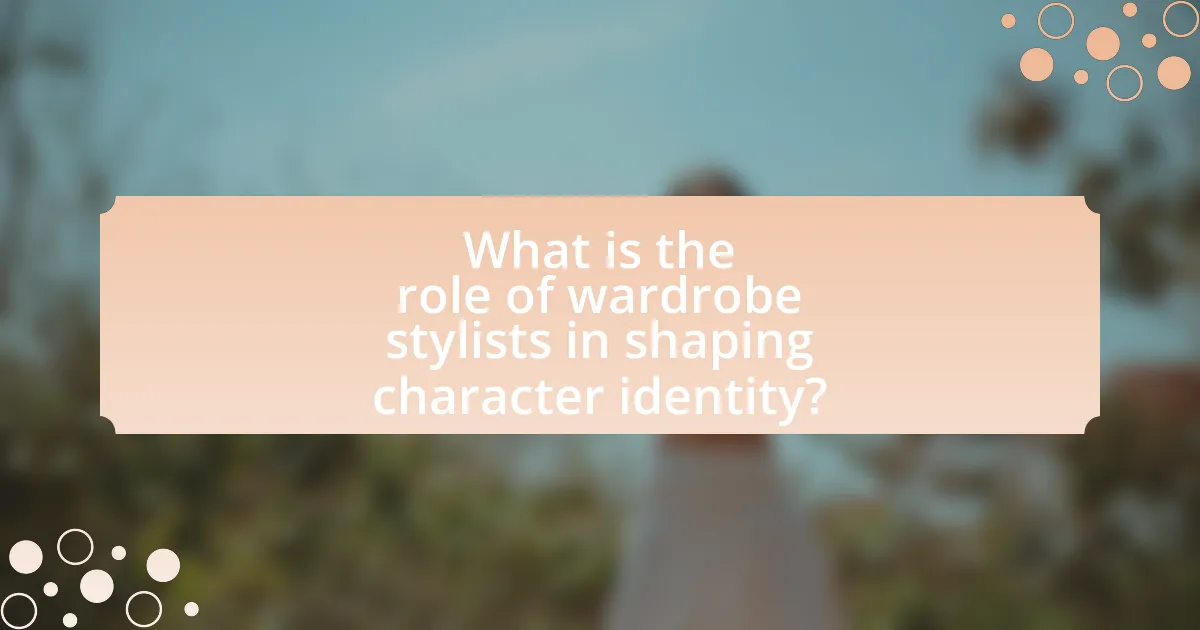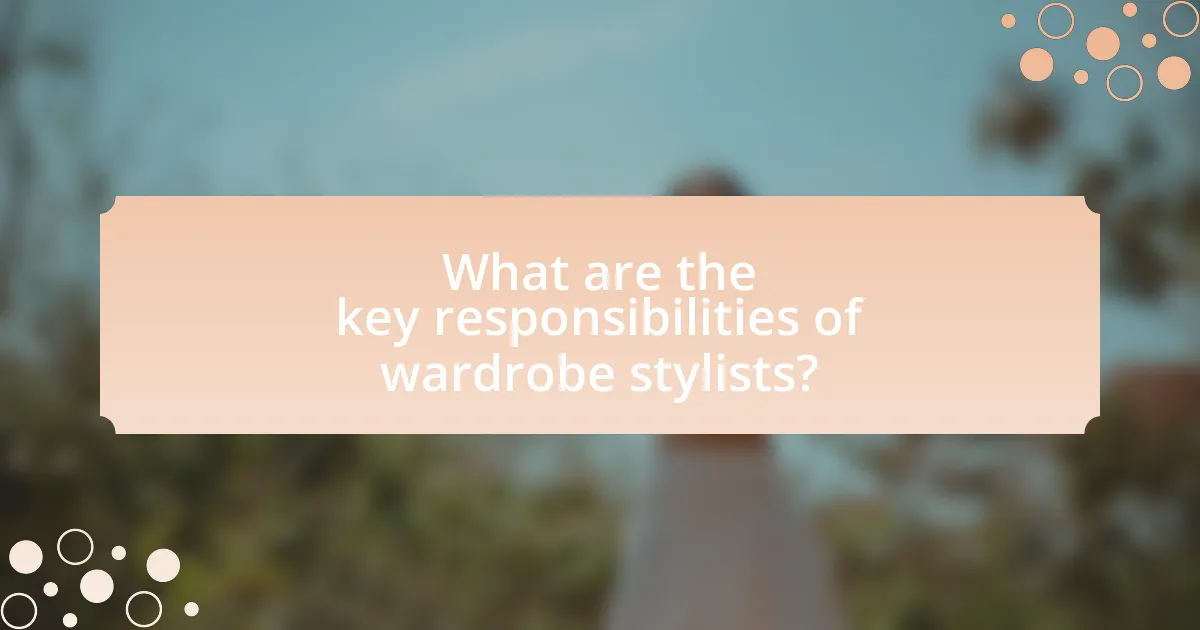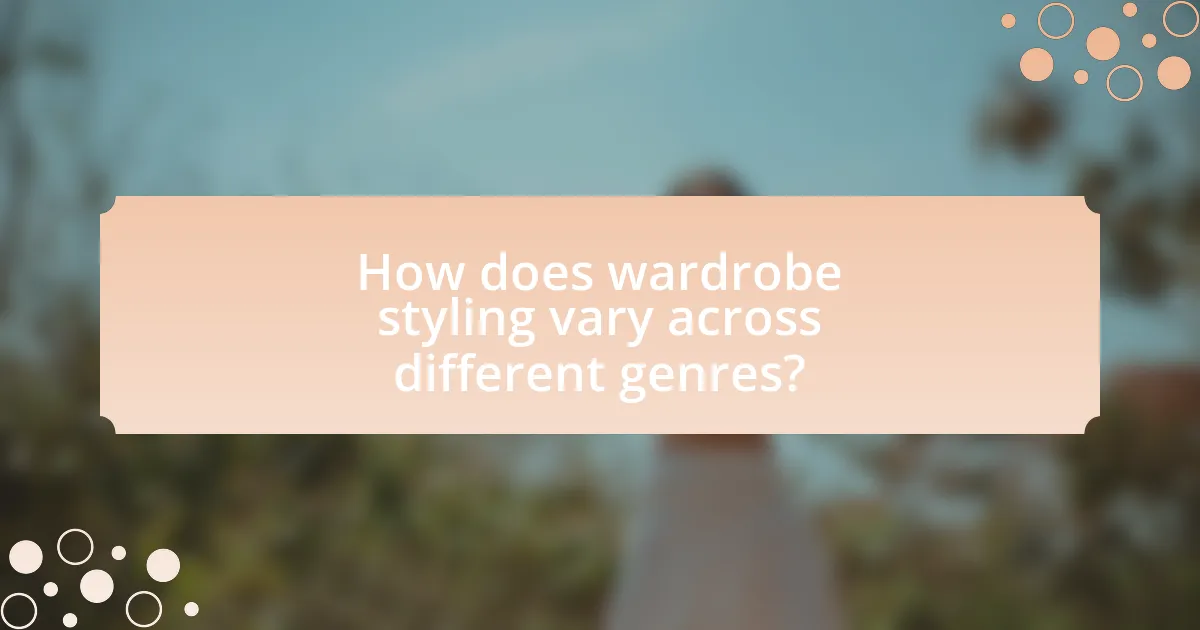Wardrobe stylists are essential in shaping character identity by selecting clothing and accessories that reflect a character’s personality, background, and emotional state. Their role involves analyzing scripts, collaborating with directors and actors, and employing techniques such as color theory and silhouette selection to enhance character portrayal. The article explores how wardrobe choices influence audience perception, the historical context of styling, and the collaboration process between stylists and production teams. Additionally, it addresses the challenges stylists face, the impact of budget constraints, and best practices for aspiring stylists to succeed in the industry.

What is the role of wardrobe stylists in shaping character identity?
Wardrobe stylists play a crucial role in shaping character identity by selecting clothing and accessories that reflect the character’s personality, background, and emotional state. This selection process involves analyzing the script, understanding the character’s journey, and collaborating with directors and actors to ensure visual coherence. For instance, in film and television, a character’s wardrobe can signify their social status, profession, or transformation throughout the narrative, as seen in productions like “The Devil Wears Prada,” where fashion choices directly correlate with character development. Thus, wardrobe stylists significantly influence how audiences perceive and connect with characters, making their role essential in storytelling.
How do wardrobe stylists influence character perception?
Wardrobe stylists influence character perception by carefully selecting clothing and accessories that reflect and enhance a character’s personality, status, and emotional state. For instance, a character dressed in high-fashion attire may be perceived as affluent and confident, while a character in worn-out clothing may evoke sympathy or depict struggle. Studies in film and television have shown that visual cues, such as color and style, significantly impact audience interpretation of characters; for example, a character in dark colors may be viewed as villainous or mysterious, while bright colors can suggest positivity or innocence. This strategic use of wardrobe not only aids in storytelling but also shapes audience expectations and emotional responses, reinforcing the importance of wardrobe stylists in character development.
What techniques do stylists use to convey character traits?
Stylists convey character traits through techniques such as color theory, silhouette selection, and fabric choice. Color theory allows stylists to evoke emotions and associations; for instance, red can signify passion or aggression, while blue often represents calmness or trustworthiness. Silhouette selection helps define a character’s personality; a structured, tailored outfit may suggest authority, while loose, flowing garments can indicate freedom or nonconformity. Fabric choice further enhances character portrayal; luxurious materials may imply wealth or sophistication, while rugged fabrics can suggest a more practical or adventurous nature. These techniques are grounded in psychological principles and visual storytelling, making them effective in shaping audience perceptions of characters.
How does clothing choice impact audience interpretation of characters?
Clothing choice significantly impacts audience interpretation of characters by conveying personality traits, social status, and emotional states. For instance, a character dressed in formal attire may be perceived as authoritative or successful, while casual clothing can suggest a laid-back or rebellious nature. Research indicates that visual cues, such as clothing, play a crucial role in shaping first impressions; a study published in the Journal of Experimental Social Psychology found that clothing can influence perceptions of competence and trustworthiness. Therefore, wardrobe stylists play a vital role in character development by carefully selecting outfits that align with the intended portrayal, ultimately guiding audience interpretation.
Why is wardrobe styling important in film and television?
Wardrobe styling is crucial in film and television because it visually communicates character identity and enhances storytelling. The clothing choices made by wardrobe stylists help establish a character’s personality, social status, and emotional state, which are essential for audience engagement. For instance, a study by the University of Southern California found that viewers often make quick judgments about characters based on their attire, influencing their perception and emotional connection to the story. This underscores the importance of wardrobe styling in creating a believable and immersive narrative experience.
What historical context has shaped the role of wardrobe stylists?
The role of wardrobe stylists has been shaped by the evolution of fashion and media throughout the 20th and 21st centuries. Initially, in the early 1900s, costume designers primarily focused on theater and film, creating outfits that reflected the social norms and aesthetics of their time. The rise of Hollywood in the 1920s and 1930s further solidified the importance of visual storytelling, as stylists began to curate looks that defined characters and influenced public fashion trends. The introduction of television in the mid-20th century expanded the stylist’s role, as they became essential in crafting the identities of characters in popular shows. By the late 20th century, the emergence of celebrity culture and fashion magazines elevated stylists to key figures in the fashion industry, allowing them to shape not only character identities but also broader cultural trends. This historical context illustrates how wardrobe stylists have transitioned from behind-the-scenes creators to influential tastemakers in both media and fashion.
How do wardrobe stylists collaborate with directors and actors?
Wardrobe stylists collaborate with directors and actors by interpreting the vision of the production and ensuring that costumes align with character development and narrative themes. This collaboration involves discussions where directors outline their creative vision, while stylists provide insights on how clothing can enhance character portrayal. For instance, stylists may present mood boards and fabric samples to directors and actors, facilitating a visual dialogue that helps refine the overall aesthetic. Additionally, actors often provide input on their comfort and personal style, which stylists incorporate to create authentic representations of their characters. This teamwork is crucial in achieving a cohesive look that supports storytelling, as evidenced by successful productions where costume design significantly impacts audience perception and character believability.

What are the key responsibilities of wardrobe stylists?
Wardrobe stylists are primarily responsible for selecting and coordinating clothing and accessories for individuals, ensuring that the chosen outfits align with the desired image or character identity. They analyze the client’s needs, preferences, and the context of the event or production, which may include fashion shows, photo shoots, or film and television projects. Additionally, wardrobe stylists often collaborate with designers, costume departments, and other creative professionals to create cohesive looks that enhance storytelling and visual appeal. Their expertise in fashion trends and color theory allows them to make informed choices that reflect the character’s personality and narrative, thereby significantly influencing the overall aesthetic and impact of the visual presentation.
How do wardrobe stylists select clothing for characters?
Wardrobe stylists select clothing for characters by analyzing the character’s personality, background, and the narrative context of the story. They begin by collaborating with directors and writers to understand the character’s role and traits, which informs their choices. For instance, a character portrayed as wealthy may wear designer labels, while a more rugged character might opt for practical, worn clothing. Additionally, stylists consider the time period and setting of the story, ensuring that the clothing aligns with historical accuracy or thematic elements. This methodical approach is supported by the fact that visual storytelling relies heavily on clothing to convey character identity, as seen in studies highlighting the impact of costume design on audience perception in film and theater.
What factors do stylists consider when choosing outfits?
Stylists consider several key factors when choosing outfits, including the client’s personal style, body type, occasion, and current fashion trends. The client’s personal style reflects their individuality and preferences, which guides the stylist in selecting pieces that resonate with the client’s identity. Body type is crucial, as stylists aim to enhance the client’s best features while ensuring comfort and fit. The occasion dictates the appropriateness of the outfit, whether it’s for a formal event, casual outing, or professional setting. Current fashion trends inform stylists about popular colors, patterns, and styles, ensuring that the chosen outfits are contemporary and relevant. These considerations collectively help stylists create looks that not only suit the client but also align with their character identity.
How do stylists ensure authenticity in character wardrobe?
Stylists ensure authenticity in character wardrobe by conducting thorough research on the character’s background, setting, and personality traits. This involves analyzing historical context, cultural influences, and social dynamics relevant to the character’s story. For instance, a stylist may reference specific fashion trends from the character’s time period or geographical location to create a wardrobe that accurately reflects their identity. Additionally, stylists often collaborate with directors and writers to align the wardrobe with the character’s development throughout the narrative, ensuring that each piece of clothing contributes to the overall storytelling. This methodical approach is supported by industry practices that emphasize the importance of authenticity in visual storytelling, as seen in award-winning productions that prioritize character-driven design.
What challenges do wardrobe stylists face in their work?
Wardrobe stylists face several challenges in their work, including budget constraints, time limitations, and the need to balance client preferences with creative vision. Budget constraints often restrict the range of clothing options available, forcing stylists to make compromises that may not align with their artistic intent. Time limitations can lead to rushed decisions, impacting the quality of the final wardrobe selection. Additionally, stylists must navigate the delicate balance between meeting client expectations and expressing their own creative ideas, which can create tension in the styling process. These challenges are compounded by the fast-paced nature of the fashion industry, where trends can change rapidly, requiring stylists to stay updated and adaptable.
How do budget constraints affect wardrobe choices?
Budget constraints significantly limit wardrobe choices by restricting the variety and quality of clothing that individuals can purchase. When financial resources are limited, consumers often prioritize essential items over luxury or trendy pieces, leading to a more functional and less diverse wardrobe. Research indicates that individuals with tighter budgets tend to focus on cost-effective brands and sales, which can result in a less personalized style and fewer opportunities for self-expression through clothing. For instance, a study published in the Journal of Consumer Research found that budget-conscious shoppers often gravitate towards basic, versatile items that can be mixed and matched, rather than investing in unique or high-end fashion pieces.
What are common misconceptions about wardrobe styling?
Common misconceptions about wardrobe styling include the belief that it is solely about following trends or that it requires a large budget. Many people think that wardrobe stylists only focus on high-fashion items, neglecting the importance of personal style and individual expression. Additionally, there is a misconception that wardrobe styling is only relevant for celebrities or public figures, while in reality, it can benefit anyone looking to enhance their personal image. Studies show that effective wardrobe styling can significantly impact self-esteem and confidence, demonstrating its relevance across various demographics.

How does wardrobe styling vary across different genres?
Wardrobe styling varies significantly across different genres, as each genre has distinct visual and thematic elements that influence clothing choices. For instance, in historical dramas, wardrobe stylists prioritize period-accurate costumes to reflect the time setting, often using fabrics and designs authentic to the era, such as corsets and petticoats in Victorian settings. In contrast, science fiction genres often feature futuristic and imaginative clothing, utilizing unconventional materials and designs to convey advanced technology or alien cultures, as seen in films like “Blade Runner,” where stylists create a dystopian aesthetic through layered textures and bold silhouettes. Additionally, in romantic comedies, wardrobe styling focuses on relatable, contemporary fashion that enhances character personalities and emotional arcs, often incorporating vibrant colors and trendy accessories to evoke a light-hearted tone. Each genre’s unique requirements dictate the stylist’s approach, ensuring that wardrobe choices effectively support character identity and narrative context.
What are the distinct styling approaches in drama versus comedy?
The distinct styling approaches in drama versus comedy are characterized by their differing emotional tones and narrative intentions. In drama, wardrobe stylists focus on creating realistic, often subdued outfits that reflect the characters’ emotional states and social contexts, enhancing the seriousness of the narrative. For example, in dramatic films like “The Pursuit of Happyness,” the clothing choices emphasize struggle and authenticity, aligning with the character’s journey. In contrast, comedy styling often employs exaggerated, colorful, and whimsical outfits that amplify humor and absurdity, as seen in films like “Dumb and Dumber,” where the outrageous costumes contribute to the comedic effect. This differentiation in styling not only supports the genre’s tone but also aids in character development and audience engagement.
How do wardrobe choices reflect genre conventions?
Wardrobe choices reflect genre conventions by visually communicating the themes, emotions, and cultural contexts associated with specific genres. For instance, in horror films, dark colors and distressed clothing often signify danger and evoke fear, while in romantic comedies, bright, vibrant outfits typically represent joy and optimism. This alignment between wardrobe and genre is supported by studies showing that audiences subconsciously associate certain styles with particular narratives; for example, a 2018 study published in the Journal of Visual Culture found that viewers can predict genre based on costume design alone. Thus, wardrobe choices serve as a critical tool for stylists to reinforce genre-specific storytelling and character identity.
What role does cultural context play in wardrobe styling for different genres?
Cultural context significantly influences wardrobe styling across different genres by dictating the visual language and symbolism associated with clothing. For instance, in historical dramas, period-accurate costumes reflect the social norms, values, and aesthetics of the time, enhancing authenticity and audience immersion. In contrast, contemporary genres may utilize fashion trends to convey character identity and societal commentary, as seen in films like “Clueless,” where the wardrobe choices reflect the 1990s youth culture. Additionally, cultural references in styling can evoke specific emotions or themes, such as using traditional attire in a fantasy genre to signify heritage or lineage. This interplay between cultural context and wardrobe choices not only shapes character identity but also resonates with the audience’s understanding of the narrative.
How do wardrobe stylists adapt to character development throughout a story?
Wardrobe stylists adapt to character development throughout a story by analyzing the character’s journey and emotional arc, then selecting clothing that reflects these changes. For instance, as a character evolves from a state of vulnerability to empowerment, the stylist may transition their wardrobe from muted colors and loose fits to bold patterns and tailored silhouettes, visually representing their growth. This method is supported by the principles of visual storytelling, where clothing serves as a non-verbal cue to the audience about a character’s internal state and transformation.
What strategies do stylists use to reflect character growth through clothing?
Stylists use color, texture, and silhouette changes to reflect character growth through clothing. By altering a character’s wardrobe to include brighter colors or more sophisticated fabrics, stylists can visually signify a transformation in personality or status. For example, a character who begins in muted tones may transition to vibrant hues as they gain confidence, illustrating their emotional journey. Additionally, changes in silhouette, such as moving from oversized, baggy clothing to tailored fits, can represent a shift in self-perception and maturity. This strategic use of clothing not only enhances storytelling but also provides viewers with visual cues about the character’s development.
How do changes in wardrobe signify shifts in character identity?
Changes in wardrobe signify shifts in character identity by visually representing transformations in personality, status, or emotional state. For instance, a character who transitions from casual attire to formal wear often indicates a newfound confidence or a change in social standing. This is supported by studies in costume design, which show that clothing choices can reflect internal character development and societal roles, as seen in films where characters evolve through their wardrobe, such as in “The Devil Wears Prada,” where the protagonist’s fashion choices mirror her journey from naivety to empowerment.
What best practices should aspiring wardrobe stylists follow?
Aspiring wardrobe stylists should focus on developing a strong understanding of fashion trends, body types, and color theory. This foundational knowledge enables stylists to create looks that enhance individual character identities effectively. Additionally, building a diverse portfolio showcasing various styles and projects is crucial, as it demonstrates versatility and skill to potential clients. Networking within the fashion industry and collaborating with photographers, designers, and other stylists can lead to valuable opportunities and insights. Continuous education through workshops, online courses, and fashion events keeps stylists updated on industry changes and innovations. Lastly, effective communication with clients to understand their vision and preferences is essential for successful styling outcomes.
How can stylists build a strong portfolio to showcase their work?
Stylists can build a strong portfolio by curating a diverse collection of their best work that highlights their unique style and versatility. This includes showcasing a variety of projects, such as editorial shoots, personal styling, and costume design, to demonstrate their ability to adapt to different themes and aesthetics. Additionally, including high-quality images, detailed descriptions of each project, and testimonials from clients or collaborators can enhance the portfolio’s credibility. Research indicates that a well-organized portfolio can significantly impact a stylist’s ability to attract clients, as visual storytelling is crucial in the fashion industry.
What skills are essential for success in wardrobe styling?
Essential skills for success in wardrobe styling include a strong sense of aesthetics, knowledge of fashion trends, and excellent communication abilities. A strong sense of aesthetics allows stylists to create visually appealing outfits that align with the client’s vision. Knowledge of fashion trends ensures that stylists can curate looks that are contemporary and relevant, which is crucial in a fast-paced industry where styles change rapidly. Excellent communication abilities facilitate collaboration with clients, designers, and other professionals, ensuring that the stylist can effectively interpret and execute the desired look. These skills collectively contribute to a wardrobe stylist’s ability to shape character identity through clothing choices.